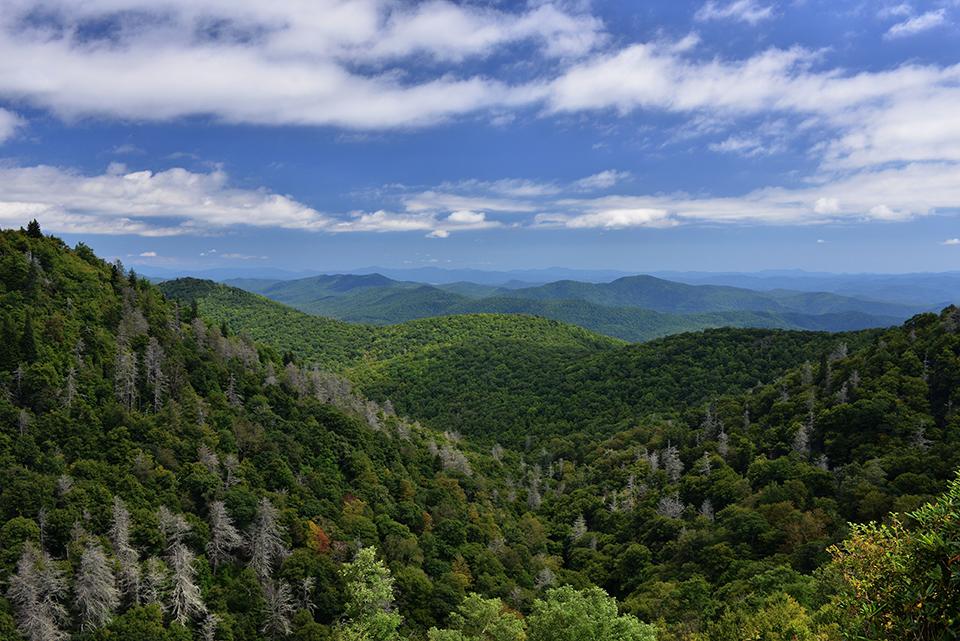
The view from the East Fork Overlook, Blue Ridge Parkway / NPS, A. Armstrong
Back in 2019, I wrote a photo article about themes. Well, I’m essentially doing the same thing regarding some of the quiz and trivia pieces I’m penning for the Traveler. It’s a “Thank You” theme to the various groups that support Traveler’s mission.
This particular piece is all about the Blue Ridge Parkway, as a thank you to the Blue Ridge Parkway Foundation. This foundation is the primary 501(c)(3) nonprofit fundraising partner for the Blue Ridge Parkway, providing support for initiatives along the 469-mile route, including historical and cultural preservation, environmental protection, visitor amenities, and education and outreach.
Test your Blue Ridge Parkway knowledge before checking the answers at the bottom of the page. You might learn something you didn’t already know, and you’ll definitely want to visit (or revisit) this amazing stretch of road winding through the Appalachians. FYI, the Traveler has published a number of articles about the Blue Ridge Parkway, including a story by Bob Janiskee (author of many previous Traveler quizzes) about Stanley W. Abbott, architect of the parkway as well as its first superintendent.

Turk's Cap lily, Blue Ridge Parkway / National Park Service
1. The Blue Ridge Parkway has an amazing variety of wildflowers. Of the 1,600 species of vascular plants that can be found within the park, what percentage are wildflowers?
a) 45%
b) 60%
c) 75%
d) 80%
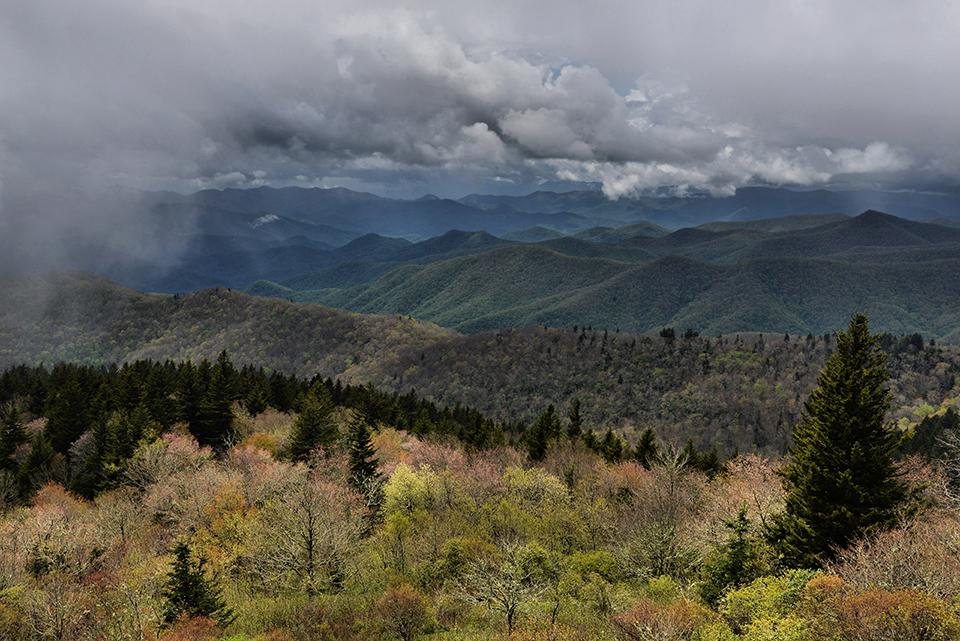
Mountains under clouds, Blue Ridge Parkway / NPS, A. Armstrong
2. Through how many mountain chains does the Blue Ridge Parkway pass?
a) Three
b) Four
c) Five
d) Six
3. There are a number of historic destinations visitors can explore along the Blue Ridge Parkway. One of them is an early tavern that went by another name:
a) Inn
b) Ordinary
c) Pubhouse
d) Public house
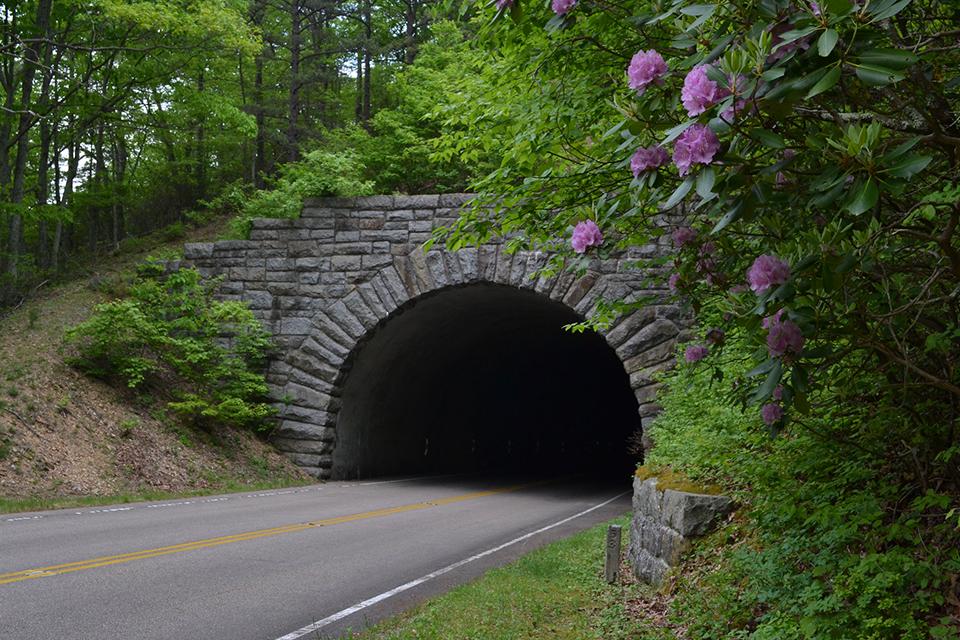
Bluff Mountain Tunnel, Milepost 53, Blue Ridge Parkway / National Park Service
4. What percentage of all road tunnels found in national parks are found on the Blue Ridge Parkway?
a) 15%
b) 27%
c) 36%
d) 45%
5. Over the last 50 years, the visibility in the Southern Appalachians along the Parkway has decreased by 40 percent in the winter and __% in the summer due to man-made pollutants.
a) 20%
b) 50%
c) 65%
d) 80%
6. “The most distinctive architectural feature of the Blue Ridge Parkway is its outstanding collection of bridges and grade separation structures, which allow the parkway to cross streams or pass safely over or under other roads.” How many bridges and grade separation structures are there along the parkway?
a) 127
b) 155
c) 168
d) 183

The Linn Cove Viaduct, Blue Ridge Parkway / National Park Service
7. “Viaducts are elevated roadway sections carrying the road high above dry ravines or across the shoulders of mountains where extensive and aesthetically unpleasing fill sections would otherwise be required…As the last piece of the parkway to be completed, the Linn Cove Viaduct is a marvelous feat of engineering and environmental protection. Completed in 1983, at a cost of almost $10 million, the Linn Cove Viaduct is 1,243 feet long and contains 153 segments, each weighing _____.”
a) 13 tons
b) 37 tons
c) 53 tons
d) 66 tons
8. One of the most popular waterfalls in the Blue Ridge Mountains is located on the parkway in an area that some call the Grand Canyon of the Southern Appalachians. What is the name of this waterfall?
a) Crabtree Falls
b) Linville Falls
c) Glassmine Falls
d) White Rock Falls
9. How many miles of hiking trails are there along the Blue Ridge Parkway?
a) 225
b) 291
c) 334
d) 369
10. What was the first restaurant to open along the Blue Ridge Parkway?
a) Peaks of Otter Lodge
b) Pisgah Inn Restaurant
c) Bluffs Coffee Shop
d) Crabtree Falls Café
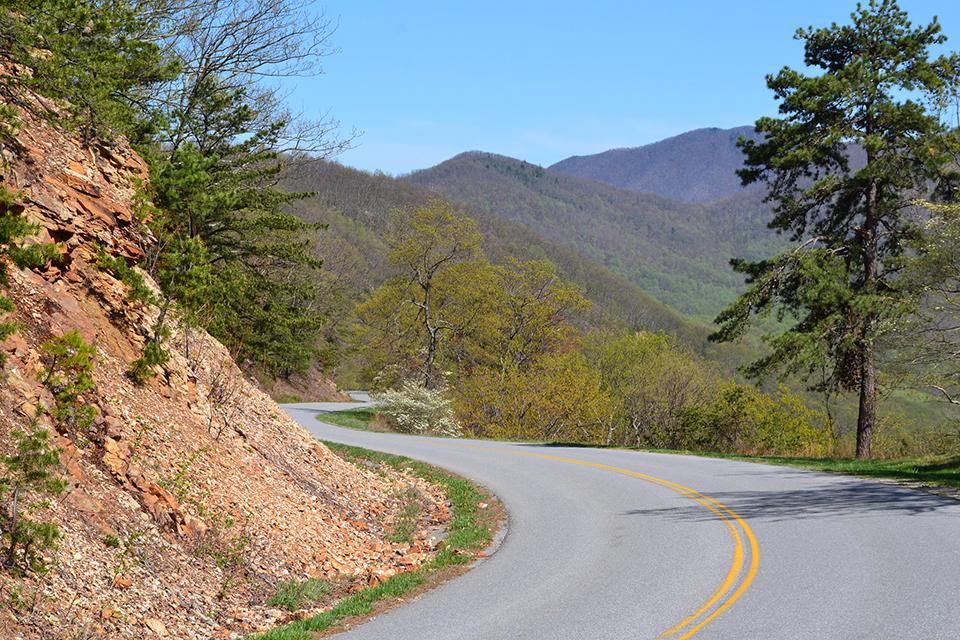
The curve of the Blue Ridge Parkway near Bear Wallow Gap, Milepost 90 / NPS-PH
Trivia
“The Parkway is the highest and longest continuous route in the Appalachian area. Along its 469-mile length, it provides scenic access to crests and ridges of six major ranges within the central and southern Appalachian Mountains, encompassing geographic and vegetative zones that range from 649 feet at James River in Virginia to 6,047 feet at Richland Balsam in North Carolina.” The Blue Ridge Parkway was deliberately created as a meandering, curving road with a slow speed limit in order for visitors to take their time and enjoy the scenic and historic vistas seen along the parkway.

Autumn color on the slopes of Apple Orchard Mountain, Milepost 70, Blue Ridge Parkway / National Park Service
“The beauty of autumn attracts large numbers of sightseers to the Blue Ridge Parkway and people often ask when "peak" season will occur. In a park that is nearly 470 miles long and varies over 5,000 feet in elevation from its highest peaks down to the foothills, there is no simple formula for predicting fall color. The intensity of fall color and time of peak color vary and are determined by complex environmental factors, as well as the genetic makeup of the plants themselves. These factors vary from plant to plant and from region to region. In fact, the timing of fall color change depends upon so many variables that the exact dates of "peak" season at specific locations along the parkway are impossible to predict in advance.” To learn more about fall colors along the Blue Ridge Parkway, click here.

Flat Top Manor, Blue Ridge Parkway / Chris Mavricos
The Blue Ridge Parkway is as much about the people around it as it is about the scenery and parkway architecture. At Milepost 294, you can visit Flat Top Manor, once the home of Moses and Bertha Cone. Moses and his brother Caesar owned mills which produced one-third of the world’s supply of denim fabric, earning Moses the nickname “Denim King.”
Ultimately acquiring 3,600 acres for Moses’ and Bertha’s Flat Top Manor estate, this summer home had all the modern amenities available in such a rural location, including hot and cold running water, indoor plumbing, telephones, and a wood-fire central heating system.
“Moses Cone chose to open the grounds of Flat Top Manor to the local community—opening the gates at 8:00 AM each morning and closing them at 6:00 PM each evening. People were welcome to walk or ride horses on the carriage trails and explore his estate, though restrictions were placed on picking flowers or hunting on the property.”
To read more details about Moses Cone and Flat Top Manor, click here.
Quiz Answers
1d
“Of the approximately 1,600 species of vascular plants that occur in the park, as much as 80 percent are wildflowers. With so many species occurring together, each has evolved to bloom at different times of the year, presumably to avoid competition of pollinators.” To read more about wildflowers found along the Blue Ridge Parkway, click here.
2d
“The parkway passes through six mountain chains in the Appalachians. From Virginia, the first 355 miles follow the Blue Ridge Mountains. Near Asheville, North Carolina, the parkway winds through the Black Mountains, the Craggies, the Pigsahs, and the Balsams. The parkway ends at the Great Smokies in North Carolina.” To read more about the mountains you’ll see along the parkway, click here.
3b
Early taverns were also known as “ordinaries.” These places offered travelers food, entertainment, and a place to stay for the night. At the Peaks of Otter (Milepost 85.6), you can explore Polly Wood’s Ordinary, “which served as the area’s first lodging starting in the 1830s.”
4c
“Tunnels are an iconic feature of the parkway. In fact, 36% of all road tunnels found in national parks across the United States are found here on the parkway. There are 25 tunnels in North Carolina and one in Virginia. These tunnels are listed below by milepost, length, maximum height (over the center of the road), and minimum height (over the edge of the road). If you are driving a large motor home, be certain that your vehicle will have enough clearance to travel through the tunnel safely.” To learn more about the tunnels found along the parkway, click here.
5d
“There has always been some pollution affecting the views in the Southern Appalachians. In fact the Blue Ridge Mountain’s name originated because of the bluish haze caused by hydrocarbons released by trees into the atmosphere. However, over the last 50 years the visibility in the Southern Appalachians has decreased 40% in the winter and 80% in the summer because of man-made pollutants.” To read more about the air quality along the parkway, click here.
6c
There are 168 bridges and grade separation structures along the Blue Ridge Parkway. To read more about these architectural features, click here.
7c
Each segment weighs 53 tons. To read more about the history of Linn Cove Viaduct, click here.
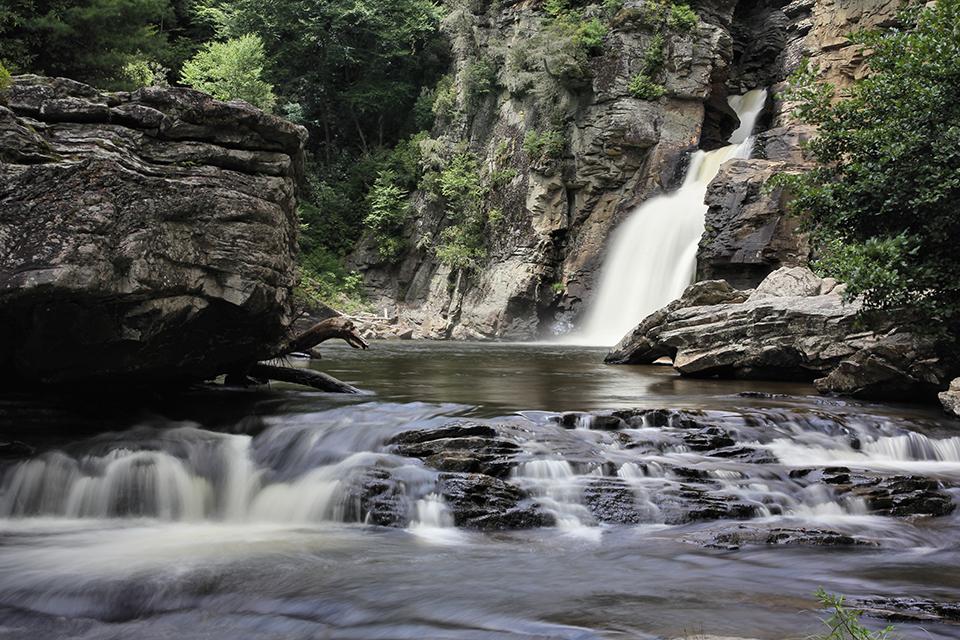
Linville Falls, Blue Ridge Parkway / NPS-A. Armstrong
8b
Located at Milepost 316, Linville Falls is one of the most popular, and impressive, falls. A number of trails takes the visitor to different views of the falls and the Linnville River. To learn more about the hiking trails around Linville Falls, click here.
9d
There are over 369 miles of hiking trails along the Blue Ridge Parkway. For a list with links to some of the more popular trails, click here.
10c
At Milepost 241, the Bluffs Coffee Shop opened in 1949 and was the first of several restaurants ever opened along the parkway. Over the years, the Traveler has written a number of articles focusing on the Bluffs Coffee Shop and you can read more about eating and sleeping along the Blue Ridge Parkway by clicking here.



Add comment